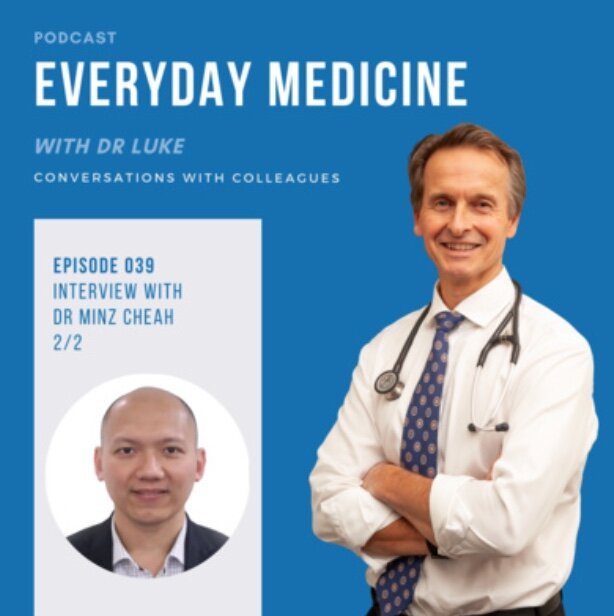Everyday Medicine by Dr Luke Crantock
Conversations with colleagues providing helpful ideas and advice in healthcare
Episode 60. Altered Uterine Bleeding with Dr Peter Yong
Altered uterine bleeding is estimated to affect 10-30% of women in midlife and constitutes about a third of outpatient gynaecological reviews. There are many aetiologies to consider including leiomyomas (fibroids), endometrial pathologies, polyps, malignancy, platelet dysfunction and coagulopathies.
Episode 59. The malignant polyp with Mr Hanumant Chouhan
The detection of colorectal polyps is of critical importance in the prevention of colorectal cancer. Studies have demonstrated that colorectal cancer arises from colorectal polyps in more than 95% of cases. Fortunately most polyps do not become malignant (less than 1%) and it is known that less than 5% of all colonic adenomas harbour malignancy. The National Bowel Cancer Screening Program has been a government initiative to assist in the detection of early cancers and malignant polyps through the detection of occult haemoglobin in stool and some larger clinical trials have demonstrated the benefits of screening population this way. Once a malignant polyp is determined colonoscopically a fresh set of questions arises in regards to best management practice.
Episode 58. Rectal Bleeding with Mr Hanumant Chouhan
Rectal bleeding is a very important clue to the possibility of serious internal colonic pathology. Whilst our approach to work up of patients with rectal bleeding is determined by the description of blood, the age of the patient and background history, it is extremely important not to overlook rectal bleeding as a possible early sign of a malignant polyp, premalignant polyp, colorectal malignancy or inflammatory bowel disease.
Episode 57. Metabolic Bone Disease with Dr Ie-Wen Sim
Metabolic bone disease is common, it is estimated that about 4.75 million Australians have either osteopenia or osteoporosis. Osteoporosis affects up to 23% of women and 6% of men over the age of 50 with a markedly increased risk of minimal trauma fractures including hip fracture with increased morbidity and mortality. Osteoporosis is characterised by microscopic architectural deterioration of bone structure, loss of bone mass and a change in bone metabolism and can be confirmed by dual-energy x-ray absorptiometry (DEXA scan). Until recently 70-85% of patients presenting with a minimal trauma fracture have tended to be both under investigated for osteopenia and osteoporosis, nor appropriately managed to prevent a further fracture. Metabolic bone disease is a silent epidemic.
Episode 56. Central mediated abdominal pain syndrome with Dr Olivia Ong
Centrally mediated abdominal pain syndrome is a chronic recurrent condition that is not related to bowel function, diet or definite organic pathology such as inflammatory bowel disease, diverticulosis, vascular syndromes nor neoplasia.
Special Episode 8. Myocarditis and Pericarditis in COVID19 patients with Dr James Sapontis
Covid vaccine induced Pericarditis-Myocarditis
Since the release of mRNA vaccines medical practitioners around the world have been receiving calls from patients complaining of chest discomfort typical of pericarditis some of these patients have also had associated ECG changes and cardiac enzyme elevation consistent with myocarditis. This phenomenon does not appear to be related to the non mRNA vaccines available.
Episode 55. Polyps with Dr Geetha Gopalsamy
Polyps are discreet mass lesions that protrude into the intestinal lumen and represent a very important precancerous pathology to be identified and removed at colonoscopy. Up to 95% of adenocarcinomas arise from polyps, such cancers develop either after inactivation of the APC gene (for adenomas) or by KRAS mutation or BRAF oncogene activation with methylation of promoter regions for the serrated polyp pathway. As colorectal cancer is one of the most commonly diagnosed cancers in Australia, with up to 1 in 18 males and 1 in 25 females developing cancer in their lifetime, identification and removal of polyps as demonstrated by the National Polyp Study remains an important objective at colonoscopy
Episode 54. Varicose Veins with Dr Louis Louizou
Up to 23% or more of Australians have varicose veins which may include small spider telangiectasias to large cosmetically challenging varicosities. In this episode we talk with phlebologist Louis Loizou who runs a very successful vein solution clinic in the community where he manages patients with all presentations of varicose veins, large, small, spider veins – he is able to find a solution for all. Louis is a past vice president and honorary secretary of the Australian College of Phlebology.
Special Episode 7: COVID19 now and in the future with Professor Erwin Loh
Newfound freedom from lockdown in both Victoria and New South Wales will undoubtedly lead to greater COVID-19 exposure. Whilst widespread vaccination uptake has been achieved a significant number of adults and our children remain unvaccinated and vulnerable to the Delta strain. What can we expect from the health perspective for those exposed?
Episode 53. Drug Harm Reduction with Gyu Lee
In this podcast we have a conversation with Gyu Lee who works with Victoria Alcohol and Drug Counselling Service as a harm reduction practitioner managing patients in the community who have developed addictions to both alcohol and drugs. Management techniques include close engagement with referred clients and an approach based on:
Episode 52. Globus with Mr Adnan Safdar
Globus pharyngeus in an intermittent or persistent non-painful sensation of a lump or foreign body in the throat. First described 2,500 years ago by Hippocrates who thought the condition was secondary to pressure on the thyroid cartilage from contractions of the strap muscles of the neck, we now know that globus is a relatively common condition representing up to 4% of ENT referrals and may be seen in just less than half of healthy individuals at some point in time. Gastro-oesophageal reflux disease and hypertonicity of the upper oesophageal sphincter are very important contributors to the sensation.
Episode 51. Facial Pain with Mr Adnan Safdar
Facial pain is a common presenting complaint in primary practice, in many cases the aetiology can be ascertained from a detailed history and examination, however the source of pain may also be obscure including referred pain from the oral cavity as well as neurological, vascular and psychogenic disorders
Episode 49. IBS with Dr Catherine Sorrell
Irritable bowel syndrome is an idiopathic clinical entity characterised by chronic (more than six months) abdominal pain that occurs in association with altered bowel habits. In 2016 the Rome IV Consensus report adjusted the diagnosis to include symptoms occurring at least once a week from a previous definition of three times a month and include the notation of abdominal pain rather than discomfort related to defaecation. In practical terms, irritable bowel syndrome is in part a diagnosis of exclusion, however, in younger patients without alarm symptoms a simple stool test for calprotectin rather than extensive endoscopic work up may be all that is required. A negative calprotectin favouring conservative and symptomatic management, a positive finding requiring further workup.
Episode 48. Eosinophilic Oesophagitis with Dr Darcy Holt
Now recognised as one of the most common conditions underlying food impaction events, eosinophilic oesophagitis (EOE) has an estimated prevalence of 0.4% among both children and adults. EOE is a chronic inflammatory disorder characterised by oesophageal dysfunction and eosinophil predominant inflammation. Relatively recently described we may speculate as to whether this is a truly new disease or a more recently recognised one.
Special Episode 6. Mental Health in a time of Covid (and the polyvagal ladder) with Brenda Sutherland
Mental health has become a major casualty of the Covid pandemic that has swept across the globe and been responsible for rolling lockdowns throughout Australia restricting personal freedoms, social contact and the ability to prosper financially. No one is exempt from this unprecedented event and the anxiety, depression and anguish wrought is having a major effect on the health and wellbeing of our communities.
Episode 45. Asthma with Dr Michael Ho
Australia has one of the highest rates of asthma in the world affecting about 11% of the population and in 2017/18 was responsible for 38,792 hospital admissions and 389 deaths, many of which may have been preventable. Asthma occurs when there is reversible expiratory constriction of the airways, especially the bronchioles and smaller bronchi, in response to various stimuli associated with a chronic inflammatory process. Today we are joined by Dr Michael Ho, an experienced respiratory physician who discusses:
Episode 42. Atrial Fibrillation and DOAC's with Dr Matthew Swale
Atrial fibrillation is the most commonly experienced arrhythmia increasing in prevalence with age. It is estimated that 3 in 1000 under the age of 65 years have atrial fibrillation rising to 9% of people reaching the age of 80 years. The rate of stroke in untreated atrial fibrillation ranges from 5% per year with minimally associated risk factors up to 15-20% per year with associated risk factors such as hypertension, diabetes mellitus, heart failure and a history of vascular disease. The mortality of atrial fibrillation related to stroke is high and estimated at 25% in 12 months.
Episode 39. Muscle Joints Aches and Pains with Dr Minz Cheah
Based on the Australian Bureau of Statistics National Health Survey data about one in three people over the age of 18 living in Australia have hypertension or were taking blood pressure lowering medications. A staggering number requiring therapy for a condition which impacts on cerebrovascular disease, coronary artery disease, chronic kidney disease, heart failure and mortality.


















